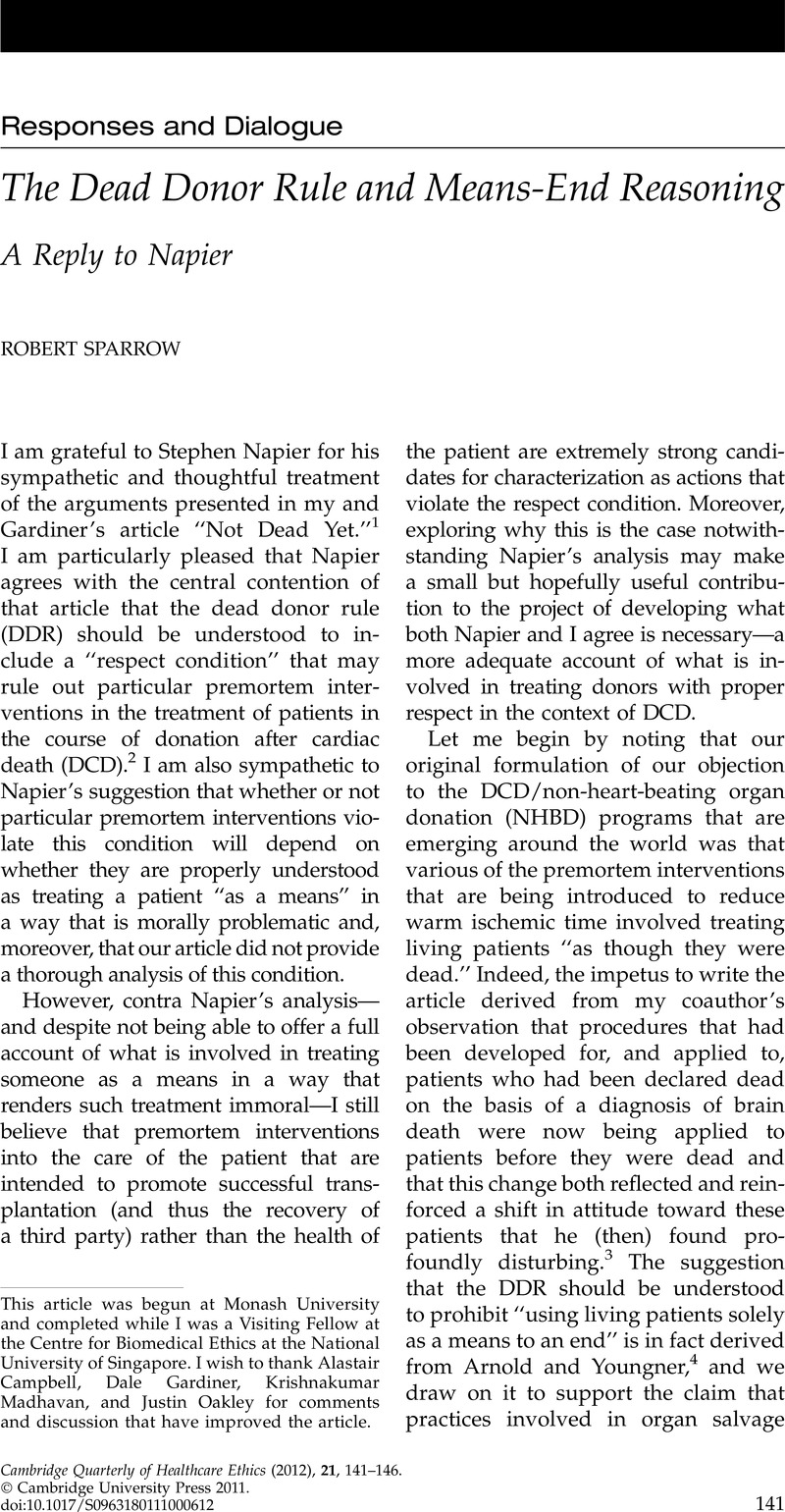Article contents
The Dead Donor Rule and Means-End Reasoning
A Reply to Napier
Published online by Cambridge University Press: 13 December 2011
Abstract

- Type
- Responses and Dialogue
- Information
- Copyright
- Copyright © Cambridge University Press 2011
References
1. Napier, S.The dead donor rule and means-end reasoning: A reply to Gardiner and Sparrow. Cambridge Quarterly of Healthcare Ethics 2011;21 (this issue).Google Scholar
2. Sparrow, R, Gardiner, D.Not dead yet: Controlled non-heart-beating organ donation, consent, and the dead donor rule. Cambridge Quarterly of Healthcare Ethics 2010;19(1):17–26.Google Scholar
3. Ironically, Dr. Gardiner, who is an intensive care specialist, has now moved into a role in which he is involved in promoting organ donation. His concern to encourage sound ethical practice was an important consideration in his decision to take on this role.
4. Arnold, RM, Youngner, SJ.The dead donor rule: Should we stretch it, bend it, or abandon it? Kennedy Institute of Ethics Journal 1993;3(2):263–78.CrossRefGoogle ScholarPubMed
5. See note 2, Sparrow, Gardiner 2010, at 21.
6. But see Cocking, D, Oakley, J.Medical experi-mentation, informed consent and using people. Bioethics 1994;8(4):293–311.CrossRefGoogle Scholar
7. This description is, of course, controversial. In particular, as we noted in our original discussion, it might be argued that these procedures are intended to produce a benefit for the donor by helping them to satisfy their desire to donate a “good” organ. However, because we treated this suggestion and its relationship to the question of the nature of the consent required for premortem procedures in our original discussion and because Napier appears to concede that these procedures are not—at least primarily—directed toward the good of the patient, I will not discuss the matter further here and will instead refer the interested reader to our original article.
8. Again, see note 6, Cocking, Oakley 1994.
9. I am not claiming here that this is an exhaustive definition of what it is not to treat someone solely as a means, only that this suffices to illustrate the relevant contrast with DCD.
10. Napier is mistaken when he attributes to us a concern that the UK was proceeding on the basis of presumed consent for organ donation (it was and is not). Our worry, rather, is that registration on the UK organ donor registry falls well short of what is required to establish informed consent to a medical procedure.
11. See note 2, Sparrow, Gardiner 2010, at 21.
12. Judicial Council of the American Medical Association. Ethical guidelines for organ transplantation. Journal of the American Medical Association 1968 Aug 5;205(6):341–2.CrossRefGoogle Scholar
13. A possibility that Renee Fox held was already being realized at the very outset of the debate about non-heart-beating transplantation. See Fox, RC. “An ignoble form of cannibalism”: Reflections on the Pittsburgh protocol for procuring organs from non-heart-beating cadavers. In: Arnold, RA, Youngner, SJ, Schapiro, R, Spicer, CM, eds. Procuring Organs for Transplant: The Debate over Non-Heart Beating Cadaver Protocols. Baltimore and London: The John Hopkins University Press; 1995:155–63.Google Scholar
- 3
- Cited by


